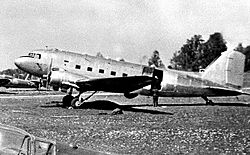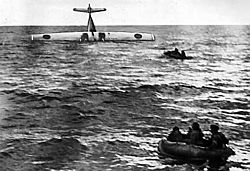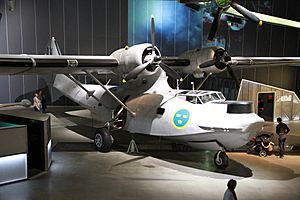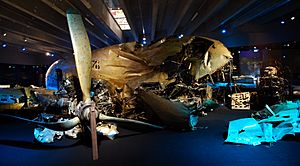Catalina affair facts for kids

Tp 79 Hugin at F 8 Barkarby in 1951.
|
|
| Incident summary | |
|---|---|
| Date | 13 June 1952 |
| Summary | Shot down |
| Place | East of Gotska Sandön 58°23.522′N 20°17.460′E / 58.392033°N 20.291000°E |
| Passengers | 0 |
| Crew | 8 |
| Fatalities | 8 (all) |
| Aircraft type | DC-3A-360 Skytrain |
| Aircraft name | Hugin |
| Airline/user | Swedish Air Force |
| Flew from | Stockholm Bromma Airport Stockholm, Sweden |
| Flying to | Stockholm Bromma Airport |

The Catalina shot down by Soviet forces while searching for the missing Hugin.
|
|
| Incident summary | |
|---|---|
| Date | 16 June 1952 |
| Summary | Shot down |
| Place | East of Gotska Sandön |
| Passengers | 0 |
| Crew | 5 |
| Fatalities | 0 |
| Aircraft type | PBY-5 Catalina |
| Airline/user | Swedish Air Force |
| Registration | 19520616-1 |
| Flew from | F 2 Hägernäs near Stockholm, Sweden |
| Flying to | F 2 Hägernäs |
The Catalina affair (Swedish: Catalinaaffären) was a big event that happened in June 1952. It was a military problem and a diplomatic crisis during the Cold War. During this time, the Soviet Union and the United States (and their allies) were in a tense standoff, but without direct fighting.
In this event, Soviet fighter jets shot down two Swedish planes. This happened over international waters in the Baltic Sea.
The first plane shot down was a Swedish Air Force Tp 79 spy plane. It was a special version of the Douglas DC-3. This plane was collecting secret radio and radar information for the National Defence Radio Establishment. Sadly, all eight people on board were lost.
The second plane shot down was a Swedish Air Force Tp 47. This was a Catalina flying boat. It was helping to search for the missing DC-3. The five people on the Catalina were rescued after their plane was hit.
For many years, the Soviet Union said they were not involved. They only admitted what happened in 1991, when the Soviet Union broke apart. Both planes were found in 2003, and the DC-3 was brought up from the sea.
Contents
The Missing DC-3 Plane
The first plane involved was a Swedish Air Force Douglas DC-3A-360 Skytrain. In Sweden, it was called Tp 79 and had the number 79001. People often just called it "the DC-3."
This plane was built in 1943 for the US Air Force. It flew in North Africa before coming to Europe. In 1946, it became a civilian plane in Sweden.
On June 13, 1952, the DC-3 disappeared east of the island of Gotska Sandön. It was on a secret mission to gather electronic information for the Swedish National Defence Radio Establishment (FRA). All eight crew members were lost. Three of them were military, and five were civilian experts.
The Catalina Search Plane
Three days after the DC-3 disappeared, on June 16, 1952, two Catalina flying boats were searching for it. They were looking north of Estonia.
One of these planes, number 47002, was shot down by Soviet aircraft. But the five crew members managed to land their plane on the water near a West German ship called Münsterland. They were all rescued safely.
What Happened After
The Soviet Union first said they did not shoot down the DC-3. But a few days later, a life raft from the DC-3 was found. It had pieces of Soviet shells in it.
In 1956, the Soviet leader Nikita Khrushchev met the Swedish Prime Minister Tage Erlander. Khrushchev admitted that the Soviet Union had shot down the DC-3. However, this information was kept secret from the public for a long time.
For almost 40 years, Sweden claimed the DC-3 was just on a training flight. But after families of the crew members pushed for answers, Swedish authorities finally confirmed the truth. The DC-3 had special British equipment and was spying for NATO.
In 1991, a Russian general named Fyodor Sjinkarenko admitted he had ordered the DC-3 to be shot down. He said he sent a MiG-15 fighter jet to stop it.
Finding the Wreckage
On June 10, 2003, a pilot named Anders Jallai and a historian named Carl Douglas found the DC-3. They used special sonar equipment. The plane was found at a depth of about 126 meters (413 feet).
Later, the Catalina plane was also found. It was about 22 kilometers (14 miles) east of where it was thought to have landed on the water.
After 52 years, the DC-3 wreckage was brought to the surface on March 19, 2004. It was frozen in a large block of mud to keep it together. The wreck was taken to a naval base for study and to be kept safe.
Finally, on May 13, 2009, the DC-3 was put on display at the Swedish Air Force Museum in Linköping. A smaller model of the plane was also given to the museum.
What We Learned
Bullet holes on the DC-3 (number 79001) showed that it was indeed shot down by a MiG-15bis fighter jet. We also know the exact time it crashed. One of the clocks in the cockpit had stopped at 11:28:40 AM Central European Time.
So far, the remains of four of the eight crew members have been found and identified.
Images for kids
-
A memorial stone for the fallen crew at Galärvarvskyrkogården in Stockholm.
See also
 In Spanish: Incidente Catalina para niños
In Spanish: Incidente Catalina para niños




